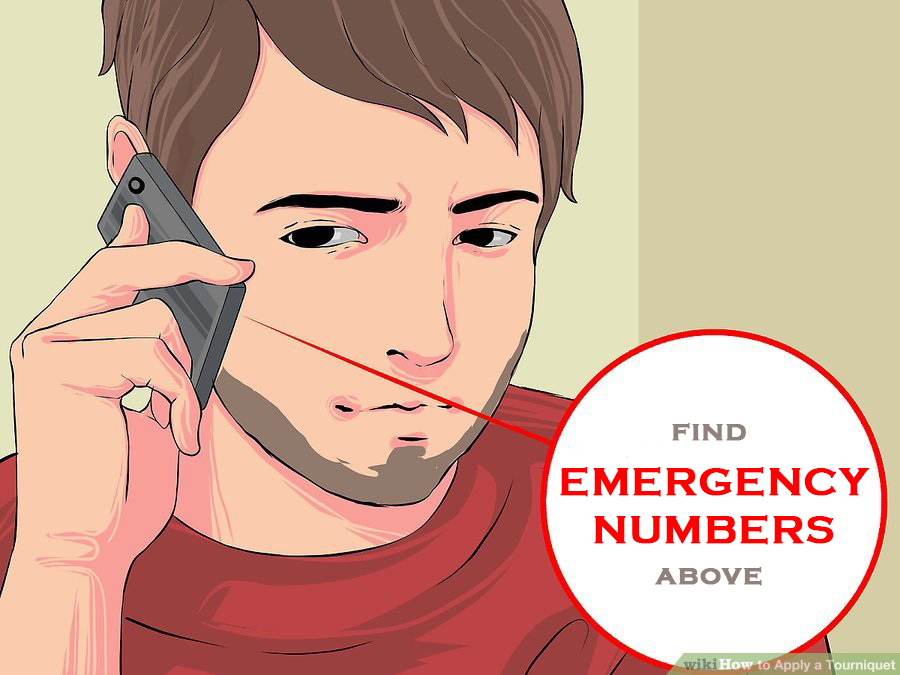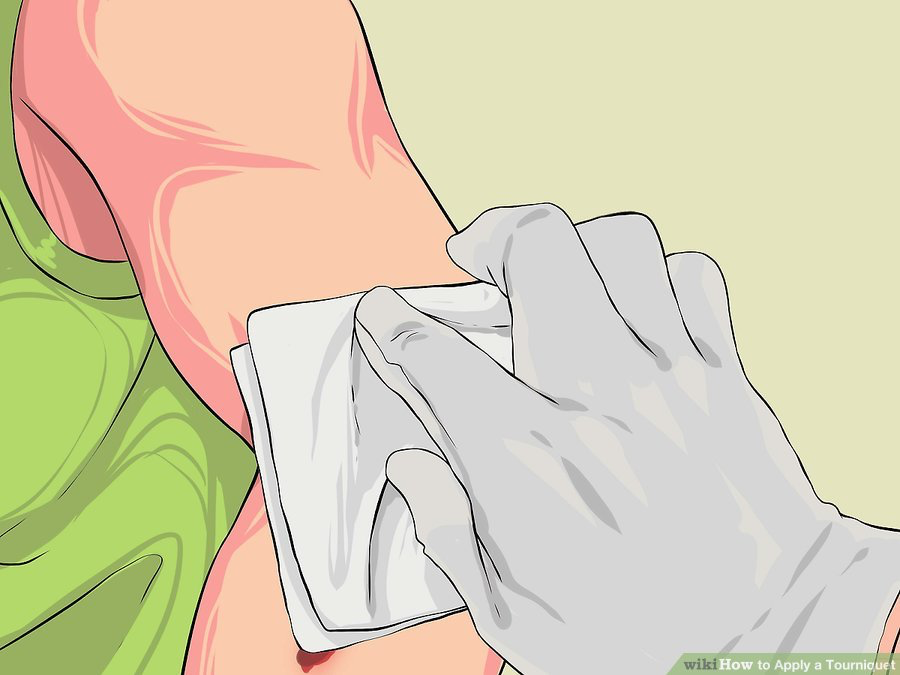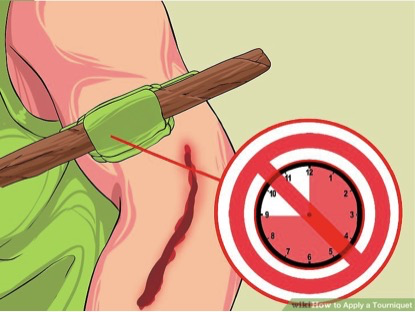Back First Aid Explained
How to apply a tourniquet

We have selected the following expert medical opinion based on its clarity, reliability and accuracy. Credits: Sourced from the website wikiHow. Please refer to your own medical practitioner for a final perspective, assessment or evaluation.
Overview
Tourniquets are tight bands applied to injured limbs meant to control or stop the loss of blood in emergency situations. They can be used on people and pets. Tourniquets can save lives when it's difficult to receive medical attention in a timely manner. They are not a long-term solution for any severe injury, but they can be very effective at controlling bleeding in the short term until the wound can be treated by trained professionals. It's important to learn how to apply a tourniquet because improper technique (or leaving it on too long) can actually lead to dire complications, such as tissue death and amputation.
Part 1: Assessing the Injury
1. Discover where the blood is coming from
If you find yourself in an emergency situation where someone (or an animal) is severely injured and bleeding, approach with confidence and reassurance. Helping someone in a life-threatening situation is brave, but you must try to discover and assess the injury as quickly as you can. Have the person lie down and find out where the blood is coming from.
- Tourniquets only work on limb injuries, not trauma to the head or torso. Injuries to the head and torso require applied pressure with some absorptive material in order to slow or stop bleeding, not a tourniquet.
- A severely injured person may also require basic life-saving measures, such as CPR (clearing airways, mouth-to-mouth resuscitation, chest compressions) and shock prevention.
- The term "tourniquet" originated in the late 1600s from the French word "tourner," which means to turn or tighten.
2. Apply pressure to the wound
The majority of external bleeding injuries can be controlled by direct pressure. Therefore, grab something absorptive and preferably clean, such as a sterile gauze pad (although it may have to be your own shirt), and place it over the wound while applying significant pressure. The aim is to plug the wound and promote blood clotting, because blood will not coagulate while freely flowing. Gauze pads (or something absorptive such as terrycloth or cotton fabric) work well to prevent the blood from escaping the wound. If the gauze, towel, or article of clothing soaks through with blood, add another layer — don't take off the original make-shift bandage. Peeling off a blood-soaked bandage from the wound removes the quickly forming clotting factors and encourages bleeding to resume. However, if the wound is too severe and the bleeding cannot be stopped with applied pressure, then (and only then) should you consider a tourniquet.
- If left uncontrolled, bleeding will eventually lead to shock, then death.
- If at all possible, use latex or similar types of gloves while in contact with the blood of another person as it will help stop the transmission of certain diseases.
- Even if you have to use a tourniquet, leave the make-shift bandage on the wound because it will help promote clotting when the blood flow slows down.
- Elevate the wound if possible. Often the combination of pressure and reducing the pull of gravity on the flow of blood in the vessels will be enough to stop the bleeding and allow clot formation.
3. Calm the injured person down
In any emergency situation, panic is a detriment, so try to calm the person down in a reassuring tone. Prevent them from looking at their wound and the bleeding if you can, as many people are frightened by the sight of blood.You should inform them of your actions though, such as when you apply a bandage and/or a tourniquet. It's also important for the person to know that medical help is on the way.
- Try to make a quick emergency phone call (or ask a bystander) as soon as you are able (see "EMERGENCY NUMBERS" above). In most severe injuries, the use of a bandage and/or tourniquet is merely buying time so that trained medical personnel can take over and do what's necessary.
- Make the injured person as comfortable as possible while you're giving them help. Put something padded underneath their head

Part 2: Applying the Tourniquet
1. Select an appropriate material
If you have a well-designed medical tourniquet at your disposal then that's great, but in most emergency situations you'll have to improvise. In the absence of a specially designed tourniquet, choose something that is strong and pliable (although not too stretchy), but long enough to tie around the injured limb.
- Good choices would be a necktie, bandana, leather belt, straps from knapsack or handbag, cotton shirt or long stocking.
- To minimize cutting into the skin, ensure that the improvised tourniquet is at least an inch wide and preferable two to three inches in width. If the tourniquet is for a finger, a somewhat smaller width is fine, but avoid string, twine, dental floss, wire, etc.
- In an emergency situation with lots of blood, you need to resign yourself to the fact that you'll be getting blood on your clothes, so don't hesitate to use an article of clothing for a tourniquet.
2. Apply the tourniquet between the heart and injury
Place your tourniquet around the injured limb, between the open wound and the heart (or proximal to the wound) — the purpose is to cut off the strong blood flow within arteries leaving the heart, not the more superficial veins returning blood back to the heart. More specifically, place your tourniquet about two to four inches away from the edge of the wound. Don't place it directly over the wound because the arteries upstream from the injury will still drain into and out from the open wound.
- For wounds that are just below a joint (such as the elbow or knee), place your tourniquet just above and as close to the joint as you can.
- Your tourniquet should have some padding underneath it to prevent skin damage, so use the victim's clothing (pant leg or shirt sleeve) to place under it if you can.
- If your tourniquet is long enough, wrap it around the injured limb numerous times, keeping it as flat as possible. You want the tourniquet to stop blood flow in the arteries, but not cut into and damage any soft tissues while doing so.
3. Use a stick or rod for tightening
Tying a regular knot after you have tightly wrapped your tourniquet may not be sufficient to control the flow of blood, especially if the material expands a little when wet. Use some sort of elongated wooden or plastic stick or rod (at least four inches long) as a torsion device.
- First, tie a half-knot with the tourniquet, then place the rigid object on top before tying a full knot over it.
- You can then twist the elongated object until the tourniquet is tight around the injured limb and the bleeding stops.
- Small tree branches, a screwdriver or wrench, thin flashlights, or thick marker pens all work well as torsion devices for tourniquets.

Part 3: Reducing Complications
1. Don't leave the tourniquet on too long
Tourniquet use is temporary and short-term only, although there is no research that indicates exactly the time limit before the lack of blood supply starts to cause tissue death (necrosis), as all people are physiologically a little different.
- If necrosis sets in, then leg amputation is very likely. As a general guideline, two hours is considered the length of time a tourniquet can be tied before neuromuscular injury begins (loss of normal function) and perhaps three to four hours before necrosis becomes a serious concern. However, in an emergency situation with no medical help close by, you may have to make the choice of sacrificing a limb to save a life.
- If you think medical help will take longer than two hours to arrive, then cool the limb down with ice or cold water (while elevated) if you can — it may help delay tissue injury and loss of function.
- Mark the victim's forehead with a "T" to indicate a tourniquet has been applied, and also note the time when it was applied so medical personnel know.
2. Keep the wound as clean as you can
Ideally, your tourniquet will stop or considerably slow down the flow of arterial blood from the wound, although you should still take care to prevent any debris from landing on the injury. Any open wound is at risk of infection. Before applying a pressure bandage, rinsing the wound with clean water is a good idea, but once the gauze or bandage is applied you shouldn't remove it. However, you can prevent debris from landing on the make-shift bandage by covering it with a blanket or article of clothing.
- If you don't have any latex gloves to wear, look around or ask any bystanders for some hand sanitizer before you touch the wound.
- If you have sterile saline available, this is the best for cleaning wounds. Otherwise, alcohol, vinegar, natural honey, hydrogen peroxide, and bleach are all good antiseptics that may be available for you to use on your hands or the victim's injury before you dress it.
3. Provide warmth and hydration
If medical help is delayed for whatever reason, then the victim is likely to experience some shivering and severe thirst from blood loss. The degree to which they will experience these issues depends on the environmental conditions and amount of lost blood. Find a blanket or some clothing to keep the victim warm and give them water or juice to drink. Shivering may also be a sign of hypovolemic shock, which also causes rapid breathing, confusion, anxiety, clammy skin, bluish coloring, and loss of consciousness.
- There may not be much you can do to prevent shock, but you can tell the medical personnel your observations when they arrive.
- The greater and more rapid the loss of blood, the more severe the shock symptoms.
- Post-tourniquet syndrome typically lasts from one to six weeks and includes weakness, numbness, pallor, and stiffness in the injured limb.
_______________________________________________________________________________________________________________________
Are you a healthcare practitioner who enjoys patient education, interaction and communication?
If so, we invite you to criticise, contribute to or help improve our content. We find that many practicing doctors who regularly communicate with patients develop novel and often highly effective ways to convey complex medical information in a simplified, accurate and compassionate manner.
MedSquirrel is a shared knowledge, collective intelligence digital platform developed to share medical expertise between doctors and patients. We support collaboration, as opposed to competition, between all members of the healthcare profession and are striving towards the provision of peer reviewed, accurate and simplified medical information to patients. Please share your unique communication style, experience and insights with a wider audience of patients, as well as your colleagues, by contributing to our digital platform.
Your contribution will be credited to you and your name, practice and field of interest will be made visible to the world. (Contact us via the orange feed-back button on the right).
Disclaimer:
MedSquirrel is a shared knowledge, collective intelligence digital platform developed to share medical knowledge between doctors and patients. If you are a healthcare practitioner, we invite you to criticise, contribute or help improve our content. We support collaboration among all members of the healthcare profession since we strive for the provision of world-class, peer-reviewed, accurate and transparent medical information.
MedSquirrel should not be used for diagnosis, treatment or prescription. Always refer any questions about diagnosis, treatment or prescription to your Doctor.







